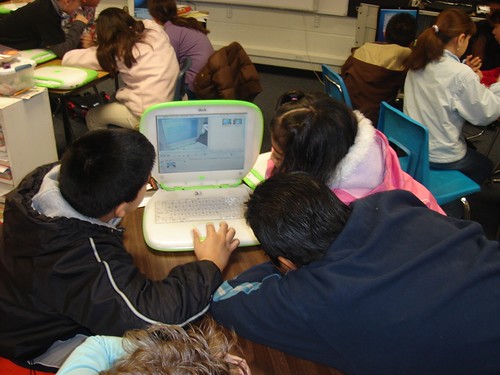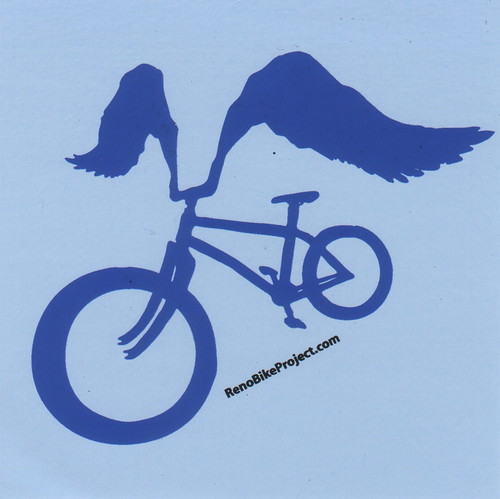I’ve had a flurry of requests … well um … several (3) readers that suggested I post a link to my TEDxDenverEd Talk Last summer – so here it is:
Leaving Their Mark – Redux
At TEDxNYED, Alan November kicked off the event with his “TALK” – Who Owns The Learning? where he asks, “Are your students leaving a legacy?” It’s a very worthwhile 15 minutes. While watching him that day I thought back to this post on my blog from 2 years ago, because it was my exact point, my students were leaving a legacy. As you read it, and perhaps follow some of the links, think about the work your students are doing:
The end of the school year is always tough. Lots still to do, lots of emotions, lots of memories. This one is tougher than most because not only are we closing in on the end of another school year, we are coming to the end of 3 years together. As I was reflecting upon this the other day it occurred to me just how large a legacy this class is leaving behind.
This has been my first experience in a 1:1 laptop classroom. It certainly isn’t all about the technology, but the technology really has leveraged what they have accomplished because it has connected them easily to so many and allowed them to share and archive those connections easily along the way.
It started in fourth grade when we began blogging and learning about being understood and being careful with language so it meant what we meant and was clear to the reader. Their blogs became a way to share their stories, but also what we did and learned and what we accomplished, and we accomplished a lot. When I broke the news to them in December of 2006 that we had a student that showed up on my attendance and that we had never seen her – but that there might be a way to include her in our classroom using Skype video-conferencing, they were intrigued and awed that we might do that. After our first experience we decided to share it with the world and in just a few short weeks the students had designed and produced a video that taught the world just how powerful these new tools can be. Their video has been downloaded thousands and thousands of times. (Update – about a million times now)
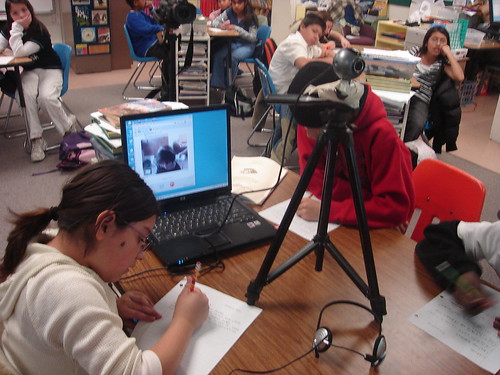
Not only did we use Skype most days to include our classmate, we also began making connections with others. We were interviewed over Skype by Lee Baber’s class in Virginia about our experience and made connections with other classrooms about science and other topics.

We were very fortunate that our classroom was chosen to have a special guest. Grace Corrigan, the mother of Christa McAuliffe, the “Teacher in Space” who died tragically when the space shuttle Challenger exploded during launch visited our room, and we Skyped out her visit to classrooms in Virginia and New York and they were able to take part in the question and answer period Grace agreed to.
To finish off that year we visited a local animal park, Animal Ark, and afterwards designed a wiki page to help further anyone’s learning about the animals there and included a lesson and video about designing your own animal.
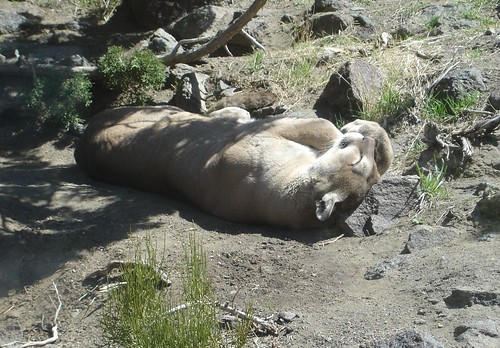
In fifth grade as we continued to blog about our experiences, my students’ exploits became known to others and so we would get contacted by schools to participate with them – usually because they didn’t know of anyone else that knew how. One such experience was Skyping in George Mayo’s middle school class from Maryland. They had made some short videos and wanted us to watch them and give them feedback. It was easier for them to have us do this than the elementary school NEXT DOOR because they were at lunch when this class met and they couldn’t work out the details. We watched and wrote our reactions to their videos and gave them feedback when we Skyped, and they asked us questions about including our classmate.
I was contacted by Skype about making a short film about our “Inclusion” experience. They sent a film crew to our classroom to shoot a mini documentary about how we did it. Even though our classmate was now with us in the classroom, they had her stay home one day and do school from her computer. They hung lights in our room and shot video all morning as we did what we usually do. They interviewed students and then packed up and shot in the afternoon from our classmate’s house. They produced 2 versions of the video. Here and here.
We continued to blog almost every day either writing new posts or reading and commenting on others. We built relationships with a number of classes around the world and to help keep track we began adding links to them on our class wiki page. Most of my students are second language learners and when we started blogging it would take most of them a week to edit a post into publishable quality. I don’t require my students to have zero errors on a piece before it publishes, but my students’ writing skills were very poor in general. They used poor English and grammar and punctuation was almost nonexistent in some students’ work. They left out the details that made meaning for the reader, and we won’t go into spelling. At first students would write their posts by hand on lined paper and edit them several times before word processing them. Next they would print them out in a large size, double spaced to have room for editing. Many students would have 5 or more copies of their story all marked up by me in 1:1 meetings with them before their work was “publishable.” That’s why it took a week. By the end of fourth grade about half the class would publish in 2 days. And by the middle of 5th grade some students were publishing the same day as the assignment was given, and almost all were publishing in 2 days. We killed a lot of trees the first year, and I (and they) felt bad about that, but the impact it had on their English, spelling, punctuation, style and more was worth it. And the students continue to write and write and write (but we don’t print very often anymore).
During fifth grade, I believe initially over Twitter, but then in email, a fifth grade teacher in New York, Lisa Parisi, mentioned to me how much she liked the comments my students left on her students’ blogs. I explained that we had really been working on the quality and substance of our comments, not just saying, “Nice post” or “I liked your post” but also explaining why. Our students began doing more reading and commenting on each others posts.
Lisa and I wanted our classes to do a project together and so the “Mysteries of Harris Burdick” writing project was born. This book, written by Chris Van Allsburg, is the ultimate writing starter I’ve ever seen. After reading and discussing the book in class our students wrote collaborative stories using Google Docs so they could work at the same time on their stories even though they were thousands of miles apart. They even discussed things over Skype so they could meet their co-writers and have discussions about where their stories were going. Other teachers joined the project and paired their classes. The project won an award.
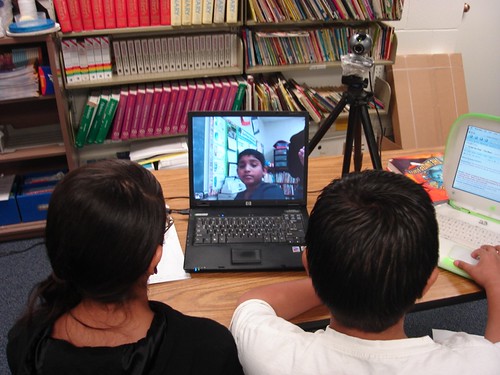
This year we participated in 2 projects that stressed being safe online. We talk about safety fairly often, pretty much anytime we use a new application – blogs, wikis, Flickr and so on and anytime it comes up in the news we tend to review the issues and what the people involved did right or wrong that caused or helped the problem that came up. We participated with a bunch of schools all over the world in the “7 Random Facts” project … sharing seven random facts about yourself without revealing any information that could identify you. By request we followed that up by participating with another class in another safety project where the students wrote vignettes about someone NOT being safe online and then wrote a moral to the story. We shared them in a Skype session with the other class. During this time students in my class shared that they had MySpace and other sites that they were really too young to have and that they had taken down inappropriate information about themselves.
The “Around the World with 80 Schools” project this year has been incredible in how it has made my students more aware of world geography as they met and talked with students on almost every continent.
Most recently we are finishing up our Reno Bike Project, project where we are helping a local non-profit organization that rehabilitates old bikes and sells them inexpensively, spread the word to get people to donate bikes to them. The Public Service Announcement and web pages they designed were just published and we are doing some other activities to help get word out.
I’ve left plenty out here to save space, but the point is these students have left a mark, a legacy that will survive their graduation to middle school and beyond. Not only have they done community service that effects their community, but they have participated globally and left the archive for others to ponder and I hope improve on. Most importantly they have vastly improved their writing, research, communication and numerous other skills along the way. They were only held back by my limitations and the limitations of the system.
I’ve learned at least as much as they have and I believe I’m a better teacher for it. I’m chomping at the bit to take what I’ve learned and share it with my new class. As of this writing I’m being moved down to 4th grade again to begin a roll up to 5th and hopefully sixth grade again. I’m really going to miss this class and I want them to know that and to know they have made more of a difference in this world than they realize. They can be proud!
Learning is messy!
My TEDxNYED Talk – Posted
Several weeks ago I had the honor of taking the stage on the 40th floor of 7 World Trade Center in New York to participate in TEDxNYED, “… an all-day conference focusing on empowering innovation in education, … being held in New York City on Saturday, March 5, 2011.”
I’d like to thank the organizers that brought me there, they were an incredible group that saw to it that things ran smoothly: Karen Blumberg, Co-Curator The School at Columbia University – Basil Kolani, Co-Curator The Dwight School – Dan Agins Pawcatuck Middle School – Sean Freese Lawrence Woodmere Academy – Kiersten Jennings Chou Independent Curriculum Consultant – Tamara McKenna The Elisabeth Morrow School – Erin Mumford – Nightingale-Bamford School – Jeff Weitz Horace Mann School
As I watched the presenters the themes that were reverberating were change, student centered learning, creativity. Find them here.
I’m afraid I went over my allotted time, a minor glitch with the timer, my fault for not noticing as I started, I take solace in that I’m not the first to do so. : )
Learning is messy!
Shuttle Launch Experience – What Are The Possibilities For Student Learning?
In my last post I shared that I have this fantastic opportunity to watch the Space Shuttle Endeavour launch from the Kennedy Space Center in Florida next month. One of the ways this new pedagogy changes things is in how my students can be included in my trip.
If I really manage to go (at best a 50-50 possibility because of budget freezes here) my students would learn about the Space Shuttle program, Cape Canaveral and other topics associated with the trip before I ever left. We would travel there through photos, but also via Google Earth – Where is this place? – why did they choose the eastern Florida coast to launch spacecraft from? We drop right down on the roof of our classroom and travel to locations and back when we Skype to build those geography skills and schema, so we would do that for this trip too. My students all have their own blogs, so I can post photos, videos, blog posts about what I am learning, topics for them to do research on. I will be able to post all my photos and even video on our class Flickr page (often within minutes of taking them) – the students could be asked to make a slideshow – write captions for the photos or any number or possible writing projects or research projects.
NASA is asking me to be there to use Twitter to report out what I am doing, seeing and learning. But I would blog about it and would hope to Skype back to my class to share with them, answer questions and maybe do on-the-spot interviews with some of the people I am supposed to meet there. My students are used to taking notes during Skype-conferences and when we have guests in our class, and this would be no different. I could have it set-up with my substitute that I would call the school and let them know to get on Skype and expect a call.
Students could even have pre-written questions to ask – what would they like to know if they get to interview an astronaut or scientist or anyone else that works there? If NASA would allow it I could use a video streaming application like USTREAM to broadcast out so other classrooms could take part … later they could even share blog posts and comments about what they learned with the classes we connect with all the time. All those students have access to our Flickr pages as well – so they could utilize our photos for their learning.
The point is, my students would not be waiting for me to return to find out what happened during the trip – to learn during the trip … they would participate before, during and after. I can comment on their blogs (even grade them), think of new assignments to give them while I am still in Florida, and my students are learning about a place they can only imagine about now. There are so many other possible ways to include them (and feel free to think out loud in the comments). And we do these things often, so this is not pie-in-the-sky – this is what we do as a big part of our learning. Things really have changed since we went to school haven’t they?
Learning is messy!
I Might Be Going To Launch Of The Space Shuttle Endeavour
NASA informed me Yesterday that I had been chosen to attend the launch of the Space Shuttle Endeavour on April 19, 2011 as part of their @NASATweetup program. I get to go and Tweet out my experience … and according to their website:
“The Tweetup will provide @NASA followers with the opportunity to tour the center, view the shuttle launch and speak with NASA managers, astronauts, shuttle technicians and engineers. The event also will provide participants the opportunity to meet fellow tweeps and NASA’s social media team.”
Too cool huh!!? The downsides are that I have to pay my own way (although I’m trying hard to get funding – probably won’t make it otherwise). And of course launch delays are not uncommon … so reservations need to be soft and you know things might happen after you’ve gotten there, but it’s all worth it!
And I won’t be alone, also according to the NASA site:
” … 150 of its Twitter followers on April 18-19 at NASA’s Kennedy Space Center in Florida. Space shuttle Endeavour is targeted to launch at 7:48 p.m. EDT on April 19, on its STS-134 mission to the International Space Station.
I informed my students today of my possible trip by having them spend 15 minutes researching the Space Shuttle Endeavour (which I managed to mis-spell “Endeavor” … which they happily informed me as their search began). Once they had learned a bit I explained what might be happening. They were pumped!
This will be the last journey of the Endeavour, as the Space Shuttles are being retired after these last hurrahs. Commander Mark Kelly (Congresswoman Giffords husband) along with his crew will head off to the International Space Station:
“… will deliver the Alpha Magnetic Spectrometer (AMS) and spare parts including two S-band communications antennas, a high-pressure gas tank, additional spare parts for Dextre and micrometeoroid debris shields.”
Here’s hoping things work out and I get to make the trip!
Learning is messy!
Long Distance Writing Assignments
 Last week when I was in New York I managed to send my students a writing assignment. I’ve done this before from China. It is not hard to do, but it’s fun for the students and anything that motivates them to write … I’m for that!
Last week when I was in New York I managed to send my students a writing assignment. I’ve done this before from China. It is not hard to do, but it’s fun for the students and anything that motivates them to write … I’m for that!
I was waiting for a train and took this photo of the tracks running to the horizon. Then I posted it on our class blog with a short prompt to write about:
“You are about to board a train. Where would you like these tracks to take you? Think of a place you’d like to go and tell the story getting there on the train!”
In this case I was fairly minimalist in my prompt, but you could say more, or even have more than one photo. Simple but effective and fun.
Now to have them take photos (or pick a photo) to turn into a story idea (kind of a reverse version).
Learning is messy!
More TEDxNYED
I think I’ve spent just about an hour (maybe more) for every minute of my TEDxNYED talk (I get 15 minutes) … I think that is ridiculous at one level … but REALLY, I’m not complaining on the other. As a preview I will say that I’m trying to spread the word about a different pedagogy .. a new REAL reform model. I am trying NOT to point my message at those that already know the message, but at those that don’t. Just remember that next Saturday … and be kind. : )
Learning is messy!
TEDxNYED – The Pressure Is On
So in a week I will be jetting across the country, weather permitting, to New York to do my 15 minutes on stage at TEDxNYED. Based on a few Tweets and emails from the last week, I’ve been relieved to learn I’m not the only one in deep, nay, in my case, almost obsessive contemplation about that 15 minutes. I will say that my goal is to share what I and so many of my colleagues have been trying, doing and having success with – with this new (maybe only newish at this point?) pedagogy. In many ways, the pressure is on.
Learning is messy!
Transparency
I love this quote from the TV show “The West Wing.” Based on a real Mars landing gone awry, CJ Cregg implores the President to still do a live TV broadcast with scientists and school children even though the spaceship has crashed due to a mistake in the math that caused it to be off by 120 feet or so (actually happened) and it smashed into the ground on Mars:
“We have at our disposal a captive audience of school children. Some of them don’t go to the blackboard or raise their hand cause they think they’re going to be wrong. I think you should say to these kids, ‘You think you get it wrong sometimes, you should come down here and see how the big boys do it’. I think you should tell them you haven’t given up hope, and that it may turn up, but in the meantime, you want NASA to put its best people in the room, and you want them to start building Galileo VI. Some of them will laugh and most of them won’t care but for some they might honestly see that it’s about going to the blackboard and raising your hand.”
Learning is messy!
How did you begin your technology journey?
A reader named Diane left these questions for me on a recent post and I thought I’d answer her here too. I wonder if others should post their experiences on their own blogs … and in more depth than I did here because of time, if that would help others somehow? Just a thought. Here are her questions and my short version answer:
How did you begin your technology journey? I would love to have access to equipment for my students to use, any suggestions on where to go to begin the process?
Hi Diane – I doubt you really want me to go all the way back to my Apple II+ days, and everyone else will be happier if I don’t : ) Most of my experiences have been chronicled here amongst all these posts. But basically I’ve been at the right spot at the right time when, because sadly so few have much experience using technology in education, my very limited experience was enough to make me the go to person. 25 years ago my class got 4 Apple II-E computers because literally in a staff meeting I raised my hand when we were asked if anyone had any experience with them and I said I used one once for a week 3 years before. It’s been like that ever since.
My classes’ 1:1 laptop experience came about because my school was getting new HP laptops and no one else wanted anything to do with our 6 or 7 year old Apple iBooks (or really even the new HP’s which to this day are used rarely by more than 1 or 2 teachers- they use them a lot though) so I explained to my principal at that time that for the price of new batteries ($3000 for 30 batteries) we could have the only 1:1 laptop class in the entire school district of 60,000 students. She had the money and we went from there. Then because we did a few things (blogs and the like) a rare time when there was some money to try out new things, our class was named the school district’s model tech class (they had to designate a classroom because a grant required that). We got an interactive whiteboard, some cameras and a few other pieces AND permission to try things out – that’s the key right there.
It’s a much longer story than that, but that’s the gist of it. Hope that helps.
Learning is messy!

